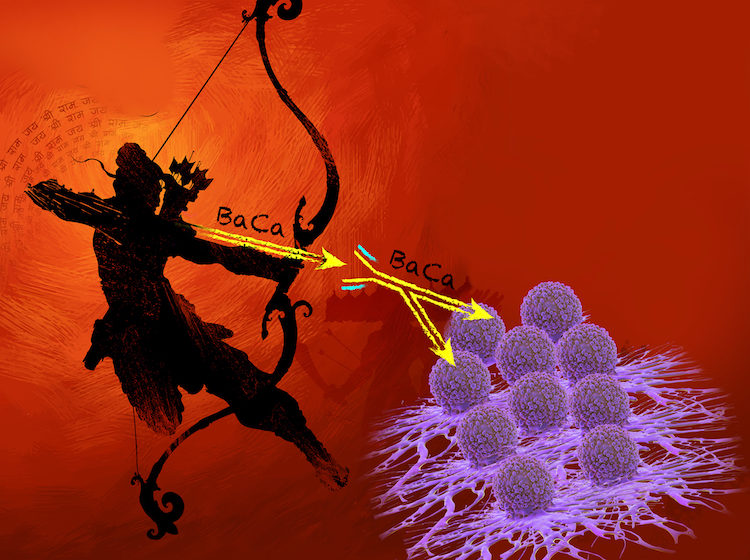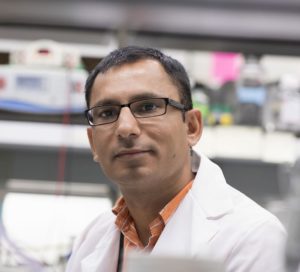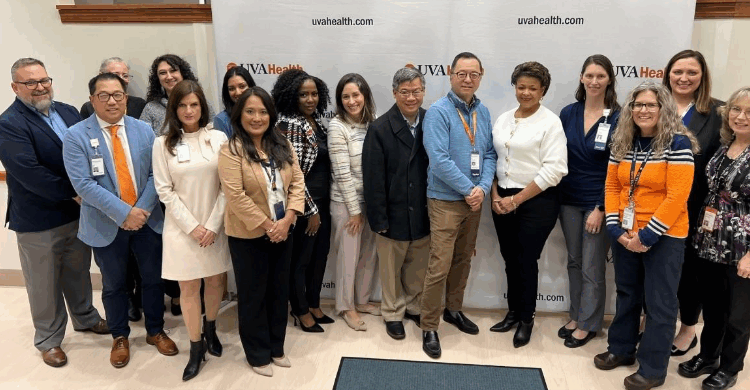
An artist's interpretation of the "two-headed" arrow UVA is developing to destroy ovarian cancer. Image by Anita Pagliazzo, as conceived and designed by Jogender Tushir-Singh.
A School of Medicine researcher is developing a two-fisted, antibody-based approach to destroy deadly ovarian cancer — an approach he believes could also be modified to kill breast, prostate and other solid tumors.
The dual-pronged approach being developed by Jogender Tushir-Singh, PhD, aims to overcome obstacles that have undermined otherwise promising immune therapies for ovarian cancer, the deadliest gynecological disease. If the approach proves successful, it may even rescue some failed therapies, allowing doctors to move them from the scrap heap to the clinic, where they could benefit patients.
“There are a lot of efforts in terms of cancer immune therapy, but the success of these are really limited in solid tumors,” said Tushir-Singh, of UVA’s Department of Biochemistry and Molecular Genetics and the UVA Cancer Center. “I strongly believe, and with my own experience while working in the pharmaceutical industry, that this advancement will allow us to rescue and give a second lease on life to a lot of antibodies that have failed in the clinic. This is all based on large amount of clinical data, and we have strategically exploited this information to improve the therapeutic efficacy against ovarian cancer.”
Targeted Treatment for Ovarian Cancer
In developing his approach, Tushir-Singh realized that a major problem with immune therapies for ovarian cancer is that the immune cells intended to kill the cancer cells cannot infiltrate the  solid tumor bed effectively. “I found that one of the problems is with the solid tumor microenvironment,” he explained. “The microenvironment is highly hypoxic, anergic and, particularly in the case of ovarian cancer, some unusually large receptors form a protective fence around tumor cells, so even if the immune cells reach there, there are many obstacles.”
solid tumor bed effectively. “I found that one of the problems is with the solid tumor microenvironment,” he explained. “The microenvironment is highly hypoxic, anergic and, particularly in the case of ovarian cancer, some unusually large receptors form a protective fence around tumor cells, so even if the immune cells reach there, there are many obstacles.”
Tushir-Singh decided to find a way to make the tumor environment more attractive despite the protective fence around it. So he engineered an antibody that he likens to a “two-headed arrow.” “The antibodies need to find a home,” he recalled thinking, “so let’s design one head to bind to a receptor that is highly expressed in ovarian tumors.”
But getting the antibody there wasn’t enough. Previous clinical trials had shown the need for antibodies that were more effective at killing ovarian cancer cells. So Tushir-Singh sought to amplify his antibody’s cancer-killing power. The result: One head of the “arrow” strikes what is known as the “death receptor” on the cancer cells, telling them to die, while the other head strikes a receptor known as FOLR1, a well-established marker that suggests a poor prognosis among ovarian cancers.
Tushir-Singh’s engineered antibodies are more than 100 times more effective at killing cancer cells than the antibodies that have made it to clinical trials, his lab work suggests. Further, his approach avoids toxicity issues that have plagued previous antibody therapies, he said. “Liver toxicity has been the biggest problem for a lot of antibodies – they are taken out of the blood too fast and accumulate where not needed,” he said. “But by providing a good home for the antibodies in the tumor, we are keeping these antibodies away from the liver.”
Findings Published
Tushir-Singh’s approach is still in the early stages of therapeutic development, but he is eager to test his two-headed arrow in people. He says his progress will depend on how quickly he can obtain funding for additional testing and for an investigational new drug (IND) filing with the federal government. “Ultimately,” he said, “a clinical trial in ovarian cancer patients is my big goal, and, with the help of the UVA Licensing & Ventures Group, we are looking for industrial partners too.”
“UVA is a great institution and a very fertile ground to do good science,” Tushir-Singh said. “With Dr. Sanchita Bhatnagar’s lab being next door, we are a collaborative husband-and-wife team. We joined UVA just three years ago. Being a young professor, I am highly thankful and admire the leadership in my department, which is chaired by Dr. Anindya Dutta, and at UVA Cancer Center, which is headed by Dr. Tom Loughran. I have been fortunate to have a great basic research team such as Dr. Kodi Ravichandran along with many others, and an effective clinical collaborator, Dr. Charles ‘Chip’ Landen.”
Tushir-Singh and his collaborators have described their approach, and the results of their initial testing in mice, in the scientific journal Cancer Cell. The research team consisted of Gururaj Shivange, Karol Urbanek, Piotr Przanowski, Justin S.A. Perry, James Jones, Robert Haggart, Christina Koska, Tejal Patki, Edward Stelow, Yuliya Petrova, Danielle Llaneza, Marty Mayo, Ravichandran, Landen, Bhatnagar and Tushir-Singh. The work is supported by a Department of Defense Research Breakthrough Award and a Institutional (UVA) American Cancer Society Award. Tushir-Singh is seeking a patent on the approach.
To keep up with the latest medical research news from UVA, subscribe to the Making of Medicine blog.
MORE FROM UVA CANCER CENTER: Pioneering 3D cancer model to speed new treatments.



